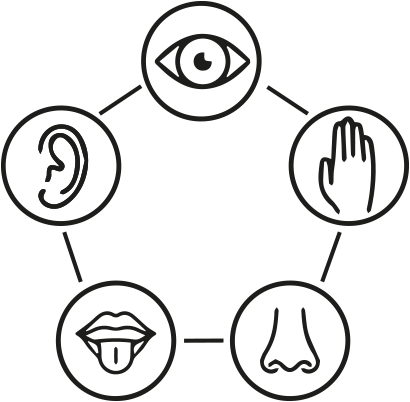Digital Sensory workshop
| Digital Sensory workshop
In Arts and Audiences elective (MA Arts and Heritage – Maastricht university) February 2020 Led by:
|
| Intended learning outcomes
Training the senses to use in analysis of museum spaces and assess impact of sensory stimuli on museum audiences |
Learning objectives (course specific)
|
| Objective statement
During the pandemic we all experienced Zoom teaching as a form of machine hybridity. Our bodies were contained in small digital squares, and we interacted with students through the skin of the screen. During that period, I developed this workshop focusing on digital sensory education for museology students. The aim was to develop sensory skills (observation, communication and use of sensory data in analysis of audience impact) |
| Type of course
Skills workshop |
Target group
|
Teaching method
|
| Activities/syllabus
Block 1 – sounds and soundscapes What does a museum sound like? Blind testing of students – they had to guess which of the sound sample is:
Most students identify the library (quiet environment) as museum. This leads to a group discussion on our assumptions of the museum on silent space and the importance of context. Read Labels with sounds: The students read (and try to memorise the content of labels) with various background sounds to identify impact on visitors:
Discussion on personal preferences, disturbances, emotional impact, etc. Impact of sound on emotion: Music as atmosphere (one painting 2 songs / impact on interpretation) The group of students is split in 2 rooms with a painting by Berthe Morisot with different soundtracks (unknowingly):
This is followed by a plenary debate by students about their interpretation of the painting, the impact of sound on their emotions and therefore interpretation of the work. Block 2 Label and wall texts sensory issues Exploring the impact of fonts/design/light on the audience Discuss the impact of the sensory on learning /cognitive capacities. Memory issue text/image exercise Impact on memory – Bransford and Johnson experiment
Block 3 Smells in museums Discussion: Favourite smell / what does it evoke? What does a museum smell like? Use of smell in exhibition (and marketing)?
Block 4 practicing touch and sensory communication Students are asked to turn off their cameras and bring an object (not necessarily art). One student at a time then describes the object only in terms of touch. Others guess the object. Repeat 3-5 times. Discussion on expressing touch and the role of touch in our relationship with objects/ museum objects. What does touch do? Imagining touch using megascan The students explore digital images of paintings (textural) in order to discuss/ describe how they imagine touch.
Block 5 – Exploring online exhibition focusing on the senses The students start exploring and analysing online exhibitions using sensory skills and analysing the impact on visitors. |
| Assessment of learning
No formal assessment |
Effect (witness account, evaluation of the course)
|
| Additional biblio sources
Workshop slides: Roppola, T. (2012). Designing for the Museum Visitor Experience. New York, NY. Howes, D. (2014) ‘Introduction to Sensory Museology’, The Senses and Society, 9:3, 259-267 Sitzia, E. (forthcoming 2023) ‘Senses and Sensibility: Finding the Balance in Sensory Museum Education’ in A. Sinner, T. Osler (ed.), Artful Xchanges: Propositions in Museum Education
|
